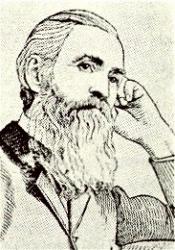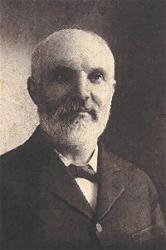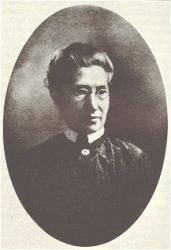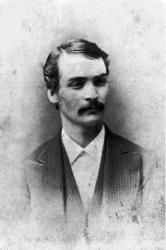Planning worship?
Check out our sister site, ZeteoSearch.org,
for 20+ additional resources related to your search.
- |
User Links
Person Results
Bill Gaither
b. 1936 Person Name: William Gaither Topics: Life to Come Author of "Porque él vive" in Celebremos Su Gloria
Bill Gaither
Sanford Fillmore Bennett

1836 - 1898 Person Name: Sanford Fillmore Bennett (1836-98) Topics: The Life to Come Author of "In the sweet by-and-by" in The Song Book of the Salvation Army Sanford Fillmore Bennett was born in Eden, New York, 21 June 1836. He and his parents moved to Plainfield, Illinois when he was two years old. He worked on the farm and attended district school during the winter. He was a voracious reader. At sixteen he entered Waukegon Academy. Two years later he began teaching at Wauconda. In 1858 he entered the University of Michigan, Afterward he had charge of the schools in Richmond, Illinois. Two years later he resigned and became Associate Editor of the Independent at Elkhorn, Wisconsin. In 1864 he enlisted in the Wisconsin Volunteers and served as Second Lieutenant. After the war he returned to Elkhorn and opened a drug store and began the study of medicine. He graduated from Rush Medical College in 1874.
Dianne Shapiro, from "The Singers and Their Songs: sketches of living gospel hymn writers" by Charles Hutchinson Gabriel (Chicago: The Rodeheaver Company, 1916)
Sanford Fillmore Bennett
Thomas Rawson Taylor

1807 - 1835 Person Name: Thomas Rawson Taylor (1807-35) Topics: The Life to Come Author of "I'm but a stranger here" in The Song Book of the Salvation Army Taylor, Thomas Rawson, son of the Rev. Thomas Taylor, some time Congregational Minister at Bradford, Yorkshire, was born at Ossett, near Wakefield, May 9, 1807, and educated at the Free School, Bradford, and the Leaf Square Academy, Manchester. From the age of 15 to 18 he was engaged, first in a merchant's, and then in a printer's office. Influenced by strong religious desires, he entered the Airedale Independent College at 18, to prepare for the Congregational ministry. His first and only charge was Howard Street Chapel, Sheffield. This he retained about six months, entering upon the charge in July 1830, and leaving it in the January following. For a short time he acted as classical tutor at Airedale College, but the failure of health which compelled him to leave Sheffield also necessitated his resigning his tutorship. He died March 7, 1835. A volume of his Memoirs and Select Remains, by W. S. Matthews, in which were several poems and a few hymns, was published in 1836. His best known hymn is "I'm but a stranger here". The rest in common use all from his Memoirs, 1836, are:—
1. Earth, with her ten thousand flowers. The love of God.
2. Saviour and Lord of all. Hymn to the Saviour. Altered as "Jesu, Immanuel" in the LeedsHymn Book, 1853.
3. There was a tims when children sang. Sunday School Anniversary.
4. Yes, it is good to worship Thee. Divine Worship. From this "'Tis sweet, 0 God, to sing Thy praise," beginning with st. ii.
5. Yes, there are little ones in heaven. Sunday School Anniversary.
-- John Julian, Dictionary of Hymnology (1907)
Thomas Rawson Taylor
Sidney E. Cox
1887 - 1975 Person Name: Sidney Edward Cox (1887-1975) Topics: The Life to Come Author of "There'll be no sorrow in God's tomorrow" in The Song Book of the Salvation Army Sidney E. Cox, 1887–1975, was a Psalm Author and Composer.
In 1907, Cox moved from England to Canada. In 1908 he joined the Methodist church but soon converted to the Salvation Army, where he worked from the years 1909 until 1944, eventually becoming a Major. After he left the Salvation Army he devoted his focus to evangelical revival work. Over the course of his life, Cox has authored or composed approximately 400 songs.
https://en.wikipedia.org/wiki/Sidney_E._Cox
Sidney E. Cox
A. Ewing
1830 - 1895 Person Name: Alexander Ewing Topics: Death and Life to Come; Life to Come Composer of "EWING" in Moravian Book of Worship Alexander C (Rex) Ewing United Kingdom 1830-1895. Born at Aberdeen,Scotland, he studied music and German at Heidelberg University and law in Aberdeen. However, he did not qualify as a lawyer. A member of the Aberdeen Harmonic Choir and the Hadyn Society of Aberdeen, he was regarded as the most talented young musician in the city. He became an author, musician, editor, composer, and translator. He married Juliana Horatia Gatty in 1867. She died in 1885, and he remarried Elizabeth Margaret Cumby in 1886. He was a career officer in the British Army's Commissariat Department and subsequently the Army Pay Corps. He served at Constantinople during the Crimean War, thereafter in China for six years, then in Ireland during the Fenian Uprising. He was then in New Brunswick just after England created the British North American Act, creating the Dominion of Canada. He then went to Fredericton, where he played the organ and sang at Christ Church Cathedral. He was transferred to Aldershot. In 1879 he went to Malta, then served in Ceylon before returning to England. He reached the rank of Lt. Col. He translated several works by other authors. He retired and spent the last six years of his life in Taunton, England, where he died.
John Perry
A. Ewing
Charles Wesley

1707 - 1788 Person Name: Charles Wesley (1707-88) Topics: The Life to Come Author of "How happy every child of grace" in The Song Book of the Salvation Army Charles Wesley, M.A. was the great hymn-writer of the Wesley family, perhaps, taking quantity and quality into consideration, the great hymn-writer of all ages. Charles Wesley was the youngest son and 18th child of Samuel and Susanna Wesley, and was born at Epworth Rectory, Dec. 18, 1707. In 1716 he went to Westminster School, being provided with a home and board by his elder brother Samuel, then usher at the school, until 1721, when he was elected King's Scholar, and as such received his board and education free. In 1726 Charles Wesley was elected to a Westminster studentship at Christ Church, Oxford, where he took his degree in 1729, and became a college tutor. In the early part of the same year his religious impressions were much deepened, and he became one of the first band of "Oxford Methodists."
In 1735 he went with his brother John to Georgia, as secretary to General Oglethorpe, having before he set out received Deacon's and Priest's Orders on two successive Sundays. His stay in Georgia was very short; he returned to England in 1736, and in 1737 came under the influence of Count Zinzendorf and the Moravians, especially of that remarkable man who had so large a share in moulding John Wesley's career, Peter Bonier, and also of a Mr. Bray, a brazier in Little Britain. On Whitsunday, 1737, [sic. 1738] he "found rest to his soul," and in 1738 he became curate to his friend, Mr. Stonehouse, Vicar of Islington, but the opposition of the churchwardens was so great that the Vicar consented that he "should preach in his church no more." Henceforth his work was identified with that of his brother John, and he became an indefatigable itinerant and field preacher. On April 8, 1749, he married Miss Sarah Gwynne. His marriage, unlike that of his brother John, was a most happy one; his wife was accustomed to accompany him on his evangelistic journeys, which were as frequent as ever until the year 1756," when he ceased to itinerate, and mainly devoted himself to the care of the Societies in London and Bristol. Bristol was his headquarters until 1771, when he removed with his family to London, and, besides attending to the Societies, devoted himself much, as he had done in his youth, to the spiritual care of prisoners in Newgate. He had long been troubled about the relations of Methodism to the Church of England, and strongly disapproved of his brother John's "ordinations." Wesley-like, he expressed his disapproval in the most outspoken fashion, but, as in the case of Samuel at an earlier period, the differences between the brothers never led to a breach of friendship. He died in London, March 29, 1788, and was buried in Marylebone churchyard. His brother John was deeply grieved because he would not consent to be interred in the burial-ground of the City Road Chapel, where he had prepared a grave for himself, but Charles said, "I have lived, and I die, in the Communion of the Church of England, and I will be buried in the yard of my parish church." Eight clergymen of the Church of England bore his pall. He had a large family, four of whom survived him; three sons, who all became distinguished in the musical world, and one daughter, who inherited some of her father's poetical genius. The widow and orphans were treated with the greatest kindness and generosity by John Wesley.
As a hymn-writer Charles Wesley was unique. He is said to have written no less than 6500 hymns, and though, of course, in so vast a number some are of unequal merit, it is perfectly marvellous how many there are which rise to the highest degree of excellence. His feelings on every occasion of importance, whether private or public, found their best expression in a hymn. His own conversion, his own marriage, the earthquake panic, the rumours of an invasion from France, the defeat of Prince Charles Edward at Culloden, the Gordon riots, every Festival of the Christian Church, every doctrine of the Christian Faith, striking scenes in Scripture history, striking scenes which came within his own view, the deaths of friends as they passed away, one by one, before him, all furnished occasions for the exercise of his divine gift. Nor must we forget his hymns for little children, a branch of sacred poetry in which the mantle of Dr. Watts seems to have fallen upon him. It would be simply impossible within our space to enumerate even those of the hymns which have become really classical. The saying that a really good hymn is as rare an appearance as that of a comet is falsified by the work of Charles Wesley; for hymns, which are really good in every respect, flowed from his pen in quick succession, and death alone stopped the course of the perennial stream.
It has been the common practice, however for a hundred years or more to ascribe all translations from the German to John Wesley, as he only of the two brothers knew that language; and to assign to Charles Wesley all the original hymns except such as are traceable to John Wesley through his Journals and other works.
The list of 482 original hymns by John and Charles Wesley listed in this Dictionary of Hymnology have formed an important part of Methodist hymnody and show the enormous influence of the Wesleys on the English hymnody of the nineteenth century.
-- Excerpts from John Julian, Dictionary of Hymnology (1907)
==================
Charles Wesley, the son of Samuel Wesley, was born at Epworth, Dec. 18, 1707. He was educated at Westminster School and afterwards at Christ Church, Oxford, where he graduated M.A. In 1735, he took Orders and immediately proceeded with his brother John to Georgia, both being employed as missionaries of the S.P.G. He returned to England in 1736. For many years he engaged with his brother in preaching the Gospel. He died March 29, 1788. To Charles Wesley has been justly assigned the appellation of the "Bard of Methodism." His prominence in hymn writing may be judged from the fact that in the "Wesleyan Hymn Book," 623 of the 770 hymns were written by him; and he published more than thirty poetical works, written either by himself alone, or in conjunction with his brother. The number of his separate hymns is at least five thousand.
--Annotations of the Hymnal, Charles Hutchins, M.A., 1872.
Charles Wesley
R. E. Hudson

1843 - 1901 Person Name: Ralph E. Hudson Topics: Life to Come Author of "La Iglesia sin mancha" in Celebremos Su Gloria Ralph Hudson (1843-1901) was born in Napoleon, OH. He served in the Union Army in the Civil War. After teaching for five years at Mt. Union College in Alliance he established his own publishing company in that city. He was a strong prohibitionist and published The Temperance Songster in 1886. He compiled several other collections and supplied tunes for gospel songs, among them Clara Tear Williams' "All my life long I had panted" (Satisfied). See 101 More Hymn Stories, K. Osbeck, Grand Rapids, MI: Kregel Publications, 1985).
Mary Louise VanDyke
R. E. Hudson
E. E. Hewitt

1851 - 1920 Person Name: Eliza Edmunds Hewitt (1851-1920) Topics: The Life to Come Author of "When we all get to Heaven" in The Song Book of the Salvation Army Pseudonym: Lidie H. Edmunds.
Eliza Edmunds Hewitt was born in Philadelphia 28 June 1851. She was educated in the public schools and after graduation from high school became a teacher. However, she developed a spinal malady which cut short her career and made her a shut-in for many years. During her convalescence, she studied English literature. She felt a need to be useful to her church and began writing poems for the primary department. she went on to teach Sunday school, take an active part in the Philadelphia Elementary Union and become Superintendent of the primary department of Calvin Presbyterian Church.
Dianne Shapiro, from "The Singers and Their Songs: sketches of living gospel hymn writers" by Charles Hutchinson Gabriel (Chicago: The Rodeheaver Company, 1916)
E. E. Hewitt
M. A. Kidder

1820 - 1905 Person Name: Mary Ann Kidder (1825-1905) Topics: The Life to Come Author of "My beautiful home, my beautiful home" in The Song Book of the Salvation Army Used pseudonym: Minnie Waters
==========
Mary Ann Pepper Kidder USA 1820-1905. Born at Boston, MA, she was a poet, writing from an early age. She went blind at age 16, but miraculously recovered her sight the following year. She was a member of the Methodist Episcopal Church. In 1844 she married Ellis Usher Kidder, a music publisher, working for the firm founded by his brother, Andrew, and they had three children: Mary Frances, Edward, and Walter. That year they moved to Charlestown, MA, and in 1857 to New York City. When the American Civil War broke out, Ellis enlisted in the 4th Regiment as a private. Mustered in for two years of service, he died of disease in 1862, six days after participating in the Battle of Antietam. Left alone, with three children to care for, her writing hobby became a much needed source of income. She began writing short stories, poems, and articles and submitting them to various magazines and newspapers. For over 25 years she wrote a poem each week to the New York Ledger and others to the Waverly Magazine and New York Fireside Companion. She also frequently contributed to the New York Weekly, Demorest’s Monthly, and Packard’s Monthly. It was estimated that she earned over $80,000 from her verse. She lost two of her children when Walter drowned while swimming, and 18 years later, her daughter, Mary Frances, a talented sketch artist, died of heart disease. Mary Ann was active in the temperance movement and one of the first members of the Sorosis club, a women’s club. She loved children and animals. Her daughter-in-law described her as gentle, patient, always serene, and a good listener. She was fiercely independent and refused to lean on others for support, mentally or materially. Mary Ann lived for 46 years in New York City. She is said to have written 1000+ hymn lyrics. She died at Chelsea, MA, at the home of her brother, Daniel, having lived there two years. It is said that her jet-black hair never turned gray, which was a real grief to her, as she longed for that in advancing age.
John Perry
===========
Kidder, Mary Ann, née Pepper, who was born in Boston, Massachusetts, March 16, 1820, is the author of "Lord, I care not for riches" (Name in the Book of Life desired), and "We shall sleep, but not for ever" (Hope of the Resurrection), both of which are in I. D. Sankey's Sacred Songs & Solos, 1878.
--John Julian, Dictionary of Hymnology, Appendix, Part II (1907)
=====================
Kidder, Mary Ann, née Pepper, p. 1576, i. Mrs. Kidder died at Chelsea, Mass., Nov. 25, 1905. She was a member of the Methodist Episcopal Church, and resided for 46 years in New York City.
--John Julian, Dictionary of Hymnology, New Supplement (1907)
M. A. Kidder
Chas. H. Gabriel

1856 - 1932 Person Name: C. Gabriel Topics: The Christian Life Death, Resurrection, Life to Come Author of "When all my labours and trials are o'er" in Churches of Christ Hymn Book Pseudonyms: C. D. Emerson, Charlotte G. Homer, S. B. Jackson, A. W. Lawrence, Jennie Ree
=============
For the first seventeen years of his life Charles Hutchinson Gabriel (b. Wilton, IA, 1856; d. Los Angeles, CA, 1932) lived on an Iowa farm, where friends and neighbors often gathered to sing. Gabriel accompanied them on the family reed organ he had taught himself to play. At the age of sixteen he began teaching singing in schools (following in his father's footsteps) and soon was acclaimed as a fine teacher and composer. He moved to California in 1887 and served as Sunday school music director at the Grace Methodist Church in San Francisco. After moving to Chicago in 1892, Gabriel edited numerous collections of anthems, cantatas, and a large number of songbooks for the Homer Rodeheaver, Hope, and E. O. Excell publishing companies. He composed hundreds of tunes and texts, at times using pseudonyms such as Charlotte G. Homer. The total number of his compositions is estimated at about seven thousand. Gabriel's gospel songs became widely circulated through the Billy Sunday-Homer Rodeheaver urban crusades.
Bert Polman
Chas. H. Gabriel


 My Starred Hymns
My Starred Hymns

